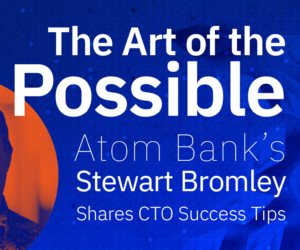At a recent conference in Paris, I joined a group of technologists for a frank conversation about the state of competition for talent in the IT industry. We agreed that finding great people can be thought of as a kind of war for talent in a world where digitization is no longer an option. Searching for solutions, we kept coming back to the concept of agile leadership.
One of the participants in the discussion was Loïc Finaz, a retired Admiral of the French Navy and expert on leadership. It was very interesting to hear the perspective of this former high-ranking military officer, whose experience has much to teach us about what it takes for an organization to attract and retain the best people, those prepared to act autonomously in service to the mission.
In a remote-first world where business transformation is the key to survival, agility has never been more paramount. We need to remind ourselves that the impulse of agile leaders is to focus on the needs of others, to integrate diverse perspectives and to empower a community that reflects the values of the organization. This is the path to building a company where the best people choose to make their contributions.
We believe that leaders who hope to compete for the best talent need to build the best agile organizations, decentralized, future-proof and mission-driven. This is the work that needs to be done. Below I summarize the conversation in six points, six lessons from agile leadership on winning the war for IT talent.

Lesson 1: Leadership is about legacy
Unlike soccer or checkers, business is a boundless game. As the great writer Simon Sinek hypothesized, in an infinite competition, the rules constantly change, time shifts, new opponents suddenly appear, and thousands of external conditions influence every decision.
In this context, the CTO (Chief Technology Officer) must focus on sustainable technology. This means thinking through the implications of a system to foster adaptation and longevity. Explaining and documenting one’s work is a safeguard against the risk of making bold choices. Planning for the future completely changes your thinking.
CTO leadership must be based on sharing information, raising the awareness of risks, and preparing everyone for the unknown. The CTO must be the anti-star, serving only the organization.
If the C-suite consumes all the company’s resources out of short- or medium-term focus, leaving none for future generations of leaders, that is also not the right way to leave a legacy.
Lesson 2: Limit the number of decisions
Confronted with the constant acceleration of technological change and the pressure of growth targets, CTOs too-often feel like they are making decisions every minute. The other side of the coin is dealing with a gradual loss of efficiency, getting farther from the “big picture.” The CTO becomes a glorified firefighter.
To avoid both pitfalls, the CTO must learn to delegate: at the heart of an agile leadership is devolving tasks to the team. Not only does this allow the CTO to show confidence in the team’s capacity, but it removes non-critical tasks.
Learning to make fewer decisions is not always easy, but it is essential, and doing so is proof of leadership maturity.
Lesson 3: Your control strategy is an illusion
Some years ago, while bathing my then 3-year-old son, he confessed that he did not nap after lunch as he was supposed to. At that time, I relied on an old-fashioned parenting style and told him I was going to punish him. He tartly replied that in that case, he would never tell me the truth again!
What a revelation! I realized then that my management approach was based on fear, on the avoidance of sanctions. In an instant, I saw that this method I created had distanced me from my teams. Digging deeper, I understood that the system was organized to hide reality from me. I decided to change completely.
In agile mode, we value the right to make mistakes and see failure as part of the journey. Easy to say, not easy to admit, yet making this shift is unavoidable.
Lesson 4: Automate recruitment of talent
The key to an efficient and fluid team is high-quality recruitment. Many CTOs are involved body and soul in the process, others delegate, most do what they can with the time they have. I prefer data.
At Pentalog, we created SkillValue Insight, an algorithm-based talent platform that analyzes tens of thousands of candidates, hundreds of thousands of tests, and provides a score based on the four essential criteria: hard skills, soft skills, English proficiency, and experience. In an ultra-competitive market, you face a double bind where you can afford neither bad hires nor delays in hiring.
To get it right, you must impose clear guidelines and eliminate unsuitable candidates. Interviews are still needed, of course, but with rational and measurable filtering of unsuitable applicants.
Lesson 5: Be the champion for repeatability
Think about the future, delegate, adopt true agility, recruit quickly … and make everything reproducible! No strategy is truly useful if you cannot do it again.
Acting with the future in mind also means working to limit unnecessary tasks. When a method is good, it should be shared, formalized, and updated as needed. For instance, at Pentalog, we have created “Maturity Models” covering a wide set of subjects and we make them accessible to all (and soon in open source). This ensures that “best practices” are available to be used by the greatest number of people. The idea is to save time, energy and let teams focus on core activities.
Efficiency abhors unnecessary processes: it wastes the time dedicated to strategy. Repeatability is a goal in itself: it is the foundation for calm leadership.
Lesson 6: Leadership begins with the mission
For many years, Pentalog viewed its mission solely as the service of customers. Who can complain about that?
Yet the time has come for us to raise the bar on our expectations of ourselves. A complex world, a loss of bearings, a search for meaning: our company must set ambitions higher than mere financial performance. In this context, we have arrived at a new mission statement: “Positive Tech Impact.” We aspire to continue working with customers to deliver business-oriented digital products, but also to do so with our values in mind.
The reality is that today’s workforce expects such commitments from the companies they join. In this sense, technical leaders who expect to work with the best talent need to consider the broader social context.
Reflections on Agile Leadership
by Admiral Loïc Finaz
Leadership is a collective notion which is based on autonomy and solidarity, the balance between the functions of each and the responsibility of all. This means optimizing the simultaneous use of the vertical and horizontal organizations of a company. Leadership is about so much more than the individual qualities of the leader alone.
You cannot be a leader without understanding that action is bound by four cardinal rules. First, the mission. Second, the meaning it has or should have. Third, the circumstances in which the mission is undertaken. And fourth, the people who accomplish the mission.
The roles of an organization are intended to provide a place for everyone, the structures, constraints, and protections to allow the organization to survive when shocks strike.
This allows delegation (a sine qua non for rapid reaction in complex situations) and releases the leader to prepare for the next move, whether given or received; and to respond to the vagueness of a mission, a lack of meaning, or the deficiency of leaders.
Admiral Loïc Finaz is a former director of the École de Guerre, the French War School, where commissioned significant buildings and recruited more than 4,000 candidates per year. Retired from active duty, he is now a management and leadership consultant.
Conclusions
The war for talent forces us all to raise our level of play, to understand the expectations of the new generation of IT talent, to review management methods and to rethink the notion of human beings at work. These are the big questions for business leaders today.
The comparison with the army is interesting because, the truth is, there is no more “agile” than the armed forces, which constantly put everything in place, with order and delegation, to allow initiative to be taken at key moments. Talk about self-organizing teams and you are talking about the ability to do the right thing without being told to do it.
The agile organization is to date the best solution to install the trust, autonomy, and responsibility of individuals. This promotes human leadership which allows everyone to develop as they wish. This is the path to creating and organization which attracts and keeps the best talent.
To hire the best, we hire smarter. Learn more how SkillValue Insight helps Pentalog recruit and retain the best technical and agile talent.











